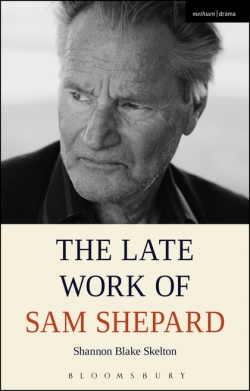The Late Work of Sam Shepard
by Shannon Blake Skelton
reviewed by Erik Hage
When Sam Shepard died in July, it became a cultural moment rife with opportunity to reexamine the often-disparate elements of his writing, his achievement, and his celebrity. His sharpest ascent came in the late ’70s and early ’80s, when he earned the Pulitzer Prize for his harrowing vision of an American family in his play Buried Child (1978) and received an Oscar nomination for his supporting-actor turn as pilot Chuck Yeager in the movie The Right Stuff(1983).
But these perceived peaks only hint at his full body of work. Shepard has earned ten Obie Awards and has written more than forty plays (as well as books of essays and stories), and beyond his numerous appearances as an actor in films, he has been a director, a screenwriter, and a musician. He even co-wrote a song, “Brownsville Girl,” (1986) with Bob Dylan.
All of this makes him arguably the most improbable and contradictory of American literary icons, a writer steeped equally in the avant-garde and the American West, whose celebrity seemed to both draw attention to his work and detract from it. Upon his death, these seemingly irreconcilable elements were on display as career-spanning tributes and obituaries flooded in.
Yet even with so much written about Shepard’s work over the decades, Shannon Blake Skelton finds new purchase with The Late Work of Sam Shepard. As the title suggests, Skelton examines the period after Shepard’s peak popularity, taking a “transmedial” approach that examines Shepard’s entire corpus, which includes not just the plays, but also his work as an actor, director, and screenwriter. In addition, Skelton explores relatively untouched terrain in Shepard scholarship, including his perspectives on politics and hegemony.
Perhaps the most interesting aspect of Skelton’s study is his willingness to engage with Shepard’s persona, which has largely emerged via his prolific work as an actor. “The public persona of Sam Shepard,” Skelton writes, “which displays a mixture of cowboy stoicism, auto-didactic intelligence, and a skeptical respect for the masculine codes of the American West, is a distinct creation of Samuel Shepard Rogers.” Skelton is interested in intertextuality within this corpus of the “Late Style”—in the “interplay between Shepard’s writing, acting, and persona.”
During this period, Skelton claims, Shepard’s roles shifted from his Gary Cooper-like, salt-of-the-earth loner to more of a paternal figure. Skelton thoroughly establishes the characteristics of the persona, sifting through performances, but he never sends the plummet quite deep enough to establish convincingly that all of this taken together is part of the same “carefully woven … transmedial fabric.” It is a bold stroke to discuss the performances in a larger creative context, but for critical purposes, Shepard the actor remains somewhat irreconcilable and separate from the writer.
Skelton’s chapter on authenticity, however, fully engages and integrates the Shepard corpus. Here, Skelton argues that Shepard “recognizes that authenticity … holds a tenuous, nuanced, and even at times ambiguously compromised relationship with the [commercial] production of art.” Shepard’s late play Kicking a Dead Horse (2007) is a full reckoning with this idea (and seemingly with his own body of work), featuring a wealthy art dealer who uses his own “authentic” southwestern origins to sell cheap southwestern art to cosmopolitan collectors. It is a wizened take on, as Skelton puts it, “the corrupting influence of commerce upon authenticity” and the artist who has become “detached from authenticity.” This is an idea that Shepard has explored before, but Skelton shows how this thread becomes more nuanced in his later works. Notions of authenticity, and the “selling” of authenticity, cut to the heart of Shepard’s career and popularity, which often relied upon the author’s reputation as a genuine, salt-of-the earth, western loner. Kicking a Dead Horse, as Skelton illustrates, shows the aging Shepard (whose career often flourished among the urban elite) wrestling with this.
This discussion trails directly into an insightful chapter on memory and trauma in the late period, reading deeply into how, for example, the play Simpatico (1994), “dramatizes the peace one attains when confronting and ‘letting go’ of the past.” This is a mature departure from Shepard’s earlier work, in which the haunted and traumatic past resonates everywhere but is rarely confronted or reconciled. Shepard’s earlier series of family plays, for example, constituted what New Yorker critic John Lahr called “an empire of the damned,” with characters caught up in a seemingly inescapable inheritance of self-destruction. But Skelton illustrates how a much older Shepard has his characters seek a path toward transformation by confronting memory and trauma.
Here, and throughout the book, Skelton explores less considered areas, and, in giving thoughtful and nuanced consideration to this late period, he stakes out important ground. The Late Work of Sam Shepard provides important context for a full understanding of the body of work.
Published on January 9, 2018

